ENCORE: NORWALK'S FIRST NATIONAL EVENT -- IT WAS JUST UGLY
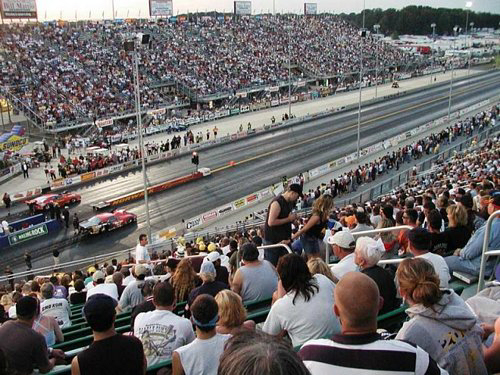
Originally published July 2014
Summit Raceway Park, formerly Norwalk Raceway Park, has now settled into its role as one of the premier NHRA event hosts, but those in racing for a while can't forget where it all started

A little over two decades ago an enterprising drag strip owner wanted a national event, but there was a problem – no one was really interested in granting him one. He took his dream to the National Hot Rod Association and the powers that be in that organization flatly told him that they saw no reason to put an event in the Cleveland area when successful events in nearby Columbus, Ohio and Indianapolis were already on the schedule.
The significantly more compromising International Hot Rod Association considered the proposal, however, and reluctantly agreed on the stipulation that certain improvements be made. Those improvements, by today’s standards, would have been the equivalent of bringing in bulldozers to level everything and start over from scratch.
The man in question was Bill Bader and the track is the now highly regarded Summit Raceway Park. In the beginning, however, Bader didn’t have a clue as to what he was getting himself into.
Ted Jones, who was then the vice president of the IHRA, arrived at the track early in the week prior to the event to watch the whirlwind of activity created as Bader struggled to get the work down and comply with a number of construction codes.
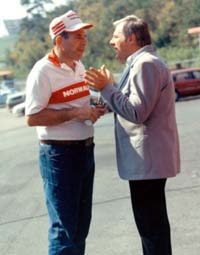
“He saw it was under construction,” Bader said, regarding Jones’ arrival at the track. “We weren’t scheduled to open the gates until Friday morning, but we had lots and lots of work to do. There was no guardrail in place for the first six hundred feet. There was no chain link fence and the grandstands were just being finished.
“Ted said to me, ‘Bill how’s it going? The race is this week, you know.’ I told him the race is Friday and this is Monday, so get the hell out of my way so I can get it finished. I think Ted was very nervous at that point,” Bader said in a classic bit of understatement.
Bader and his gang even had to wash the track down because the racing surface had become a staging area for the newly purchased grandstands. On Thursday evening, the construction was still underway, which prompted Jones to remind Bader that they needed the track on Friday.
“I assured him it would be ready by morning,” Bader said.

The biggest reason the construction went to the wire was the weather. “With our winters the building season was very limited,” Bader said. “We had to get the most work we could get done in a very limited amount of time.”
The original grandstands at NRP were purchased from a local baseball field, and had a capacity of just over 800. In advance of his first national event, Bader replaced those with bleachers capable of seating 9,000 paying customers. The new stands were bought from York U.S. 30, moved in prior to the event and assembled in the snow.
“We didn’t even have a scoreboard or a return road when we were awarded the event,” Bader said. “The grandstands weren’t even put up. The challenge of getting that done between the weather, time and staffing made it difficult. The preparation went down to the 11th hour.
“I asked myself, ‘Why did that happen?’
“It’s the age-old tradition of trying to get ten pounds of work done in eight pounds of time.”
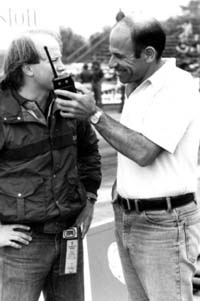
Jones recalled his first Norwalk Experience during the days leading up to the inaugural Norwalk event.
“The place was horrible and barely acceptable,” Jones, now a motorsports television producer, recalled. “We had to get Bill to put in the contract many things that had to be done before we ran the event. The thing with Bill is that he just kept improving. After a while, we didn’t have to require things – he just got it done.”
This was a minimum standard event by all accounts. Even the timing system was not up to “code.”
“Bill didn’t use the Chrondek timing system that had the 12-volt light sources,” Jones said. “Those were break-away bulbs so as not to damage the cars. He had 120-watt, 150-volt spotlights that you would put on the outside of the house. He fastened his light source to a concrete block. Obviously that would do a fair amount of damage to the cars. We had to let him know that he couldn’t use that.”
Jones said Bader complied with the IHRA’s request to make the switch to the current IHRA photocell system. One thing that impressed Jones is the way Bader became motivated and the two entities learned equally from one another.
“The thing that motivated him the most was seeing the potential these events had,” Jones said. “We learned a lot from him and vice versa. It opened a lot of doors for him as far as future large events were concerned.”
That first event, the 1981 Winston World Nationals, was an abysmal failure for Bader and the IHRA. According to Bader, the event cost $110,000 to produce and they lost $55,000.
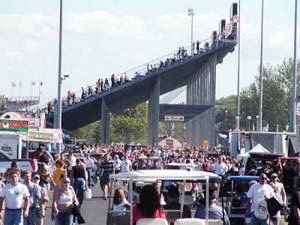
“I said to myself, ‘I just borrowed a quarter of a million dollars to do all of this stuff and I lost over fifty grand,’” Bader said. “I didn’t know what the heck I was thinking.”
“Raymond Beadle walked up to me and asked me if I wanted to flip for $50,000,” Bader said. “He asked me how much I stood to lose. He wanted to flip me for it. God bless him. He was being funny and I wasn’t much in a funny mood.”
That first event only attracted six nitro and two alcohol funny cars. Then-IHRA President Larry Carrier approached Bader with an idea that could improve or do further damage to the bottom line. What Bader didn’t know is that Carrier was baiting him to test his resolve.
“He asked me if I wanted to let the alcohol cars run,” Bader said. “He presented the option of letting them run, but it would have cost us first round money for both on an event that was already losing money. He asked me what I wanted to do.
“I told him that if we wanted to grow this race, we had to give the fans an eight car field and those were the best eight cars we had. I told him the only problem about doing it is that I didn’t know if I had the money to cover my end of the loss. Carrier then spoke up and let me know he would loan me the money.
“He just wanted to see what I was thinking,” Bader said. “That was a good lesson and a good moment between the two of us.”
A SON REMEMBERS

After purchasing the International Hot Rod Association in 1998, he turned over control of the track to his son Bill Jr. It was a big undertaking for Bader’s first-born son, as his father had set incredibly high standards, attested to by the numerous Track Operator of the Year awards bestowed upon him by the IHRA.
“Junior” was only a kid when his dad’s facility gained that monumental first national event. He remembers the good, the bad and the very ugly.
“Early on for the first few years we fought with the weather,” Junior said. “It rained and it rained and it rained. The second and third national events we held were both rained out and had to be rescheduled. I remember very early on how difficult it was. We had a tremendous investment in the facility and we were under a considerable financial burden. We always re-invested in the facility when we were able to, though, and while the event took a while to build momentum, it eventually did.
“I will always hold true to the belief that the strong sportsman base was what made this event a success,” Bader Jr. said. “Even back then we were blessed with strong sportsman car counts. Not only did it build the event, but it built the track as well.”
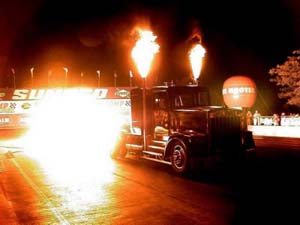
The original IHRA event had grown so much since 1981 that it regularly attracted over 1,000 entries. The majority of these are sportsman racers who have made the event a viable alternative to the week-long monster known as the NHRA U.S. Nationals.
The original version of the World Nationals was nowhere in the same ballpark as an NHRA event, much less a divisional one. That didn’t deter Bader, however, as he poured heart and soul into the event, working not only himself to death but those tough enough around him. Then there were those who had no other choice. In the Bader world, resistance was futile.
“My dad always had a dream to hold a national event,” Junior said. “In the early years of this facility, well, this facility was not nice. I think we had seating for maybe 800 people. The racing surface was in rough shape. We had no paved roads. We had a water truck that handled dust control. There was no outer perimeter fencing - just giant heaps of dirt, clay and stone that marked the borders.”

The side of NRP where the professional pits are now located was nothing more than an open field with little or no development. It was once a motocross track before becoming a parking lot.
“I think dad had the vision and the foresight, but even he had to think he’d bitten off more than he could chew in the early going.”
Bader pulled his son out of middle school for the entire week prior to the first event so that he could assist in the preparation. “It was a skeleton crew,” Junior recalled. “We literally worked around the clock. I can remember dad picking me up at 6 AM and getting home at 2 AM the next day. It went on over and over. I was supposed to work the E.T. shack and I missed the first day or two because I was sleeping from pure exhaustion.
Was Bader a slave driver in those early days?
“His idea of a lunch break was a bag of cheeseburgers that sailed out of the driver’s side window of his track as he drove by,” Junior said. “Everyone had to grab a burger as they worked.
Junior recalled his favorite story of the first week.
“We had an old rusted out pick-up truck with no doors,” he said. “We took a drum of VHT and an old pump and put them on the back. We took turns driving and spraying. I remember the overspray was so bad that my pant legs were actually glued to my boots. They all had to come off in one piece.”
That track prep yielded the IHRA’s first 250-mph Funny Car run, however, with a 254 mph blast from Billy Meyer. The inaugural event yielded five or six professional records as well.
“That first year was memorable, exciting and taxing all at the same time,” Junior said.
The driving force behind this team also included Bill’s wife Debbie and daughter Bobbie, who are still involved in the operations of the incredible facility. There were four other loyal track employees who worked alongside of the Baders.
MICRO-MANAGING TO SUCCESS
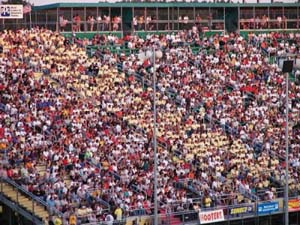
Blame it on one of Bader’s former facility managers for influencing and encouraging a style of micro-managing that has been paralleled by few. Foster Cather, who managed Sandusky Speedway for Bader in the 70s, challenged his boss to learn every aspect of the business.
Bader did just that. He carefully studied every facet of promoting, advertising and public relations. With an educational background in pre-med and real world experience as a welder and fabricator, needless to say this was foreign territory to Bader.
“I had to learn the business of promoting because I was doing a terrible job,” Bader said. “Racers, fans and employees came to me wanting things their way and I did everything I could to accommodate each and every one. I was literally walking around in the parking lot every night at 3 AM contemplating what to do.
“Foster told me that if I didn’t get a grip on things that I would drive myself into an asylum. He challenged me to go back to the things that as a racer I despised the most.”
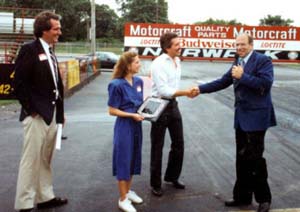
Bader did his homework and determined that foremost among those things were contesting timely races, preferential treatment to racers (because he was always on the losing end) and promoters that didn’t stick to their word.
“I had to question myself as to whether I had what it took to be a promoter,” Bader said. “I sat down one night and outlined everything I needed to be to make it work. I had to be everything from marketing manager to ticket seller to race director. I asked myself if I could be all or did I need to hire others. I asked myself if I wanted to walk away and let it all default back to the owner.
“I answered my questions by saying I didn’t buy all this just to hire someone else to run it. I was determined not to fail. I had to learn every single job at the track. That was my turning point.”
Bader had the opportunity to purchase Norwalk Dragway in the 1970s. Ironically, the purchase was derived from a proposal that included a joint ownership in another circle track.
“A businessman in Cleveland named Wayne Sergent approached me about a joint venture between he and I involving Heidelburg Raceway in Pittsburgh,” Bader said. “Because I was running Sandusky at the time, I was the first person he thought of. That property was eventually purchased by K-mart and we missed out on it.
“During the time we were working on the circle track deal he told me of a drag strip that was for sale suggested we buy the old Norwalk Dragway facility. That was November of 1973. I ended up buying it by myself.”
Bader opened Norwalk in April of 1974. “I had never seen a drag strip in my life,” he said. “I went over to Thompson Dragway so I could get an idea of what I had just bought.”
The original facility sat on just 100 acres of land, and that was on the extreme side. It had a sixty-foot wide strip of asphalt down the center and was 4,000-feet long. There were piles of asphalt and gravel all around it and of course there was a briar patch or two on the property. Only a white picket fence kept ticket jumpers on the outside.
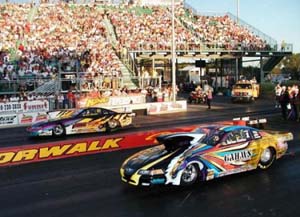
Bader even admitted to farming the left side at times. He needed something to make money, because the drag strip wasn’t.
“We lost eleven of our first thirteen weekends at the strip due to weather and other things,” he said. “We lost power two weekends in a row and one weekend we didn’t even have a timing system because lightning had struck us a few days before. The sad part is that we didn’t even know it.”
Bader even decided to call it quits and went back to the mortgage lender and told him the venture just wasn’t working. It was draining his other business interests. Bader was told the venue would make money the next year.
“Besides, he told me he didn’t want it back,” Bader said. “He guaranteed me I would make money.”
Who’d have ever thought it?
Bader didn’t.
“At the end of the year of the year, I ended up turning a profit and paying taxes on a .73-cent profit,” Bader said. “The track was actually in the black for the first time. We never looked back.”
FROM MAY TO AUGUST – A WINNER IN THE MAKING
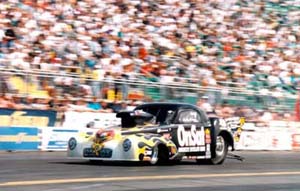
Continually refining and improving has been the secret to his success. The event is traditionally held a week prior to the U.S. Nationals in Indianapolis, but few will recall the original event took place in mid-May. It was later moved to June before settling into the twilight of August in the mid-1980s.
“The great thing about that is that we held all the professional records,” Junior said. “The air in May is always killer. We’ve even had snow on the ground here in May. The rain was bountiful as well.”
It didn’t hurt things that Bader was known as the promoter extraordinaire. Six-time Pro Modified World Champion Scotty Cannon, who at one time had a street named after him on the grounds of Norwalk Raceway Park, once recalled explaining the Norwalk Experience to a novice Norwalk attendee.
“I used to call him the P.T. F’in Barnum of drag racing and I was explaining why to someone that had never been there before,” Cannon said. “Low and behold, I couldn’t make this up, up he walks to our pits wearing a red coat - I think it even had tails on it – and he was giving out free ears of corn.
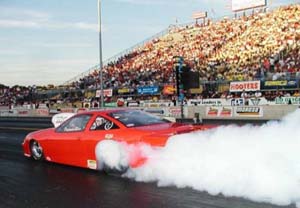
“I looked at the guy and said…do I need to explain any more?”
So impressed with Bader’s style was John Force that this season he actually had his Funny Car emblazoned with his likeness on the hood. A special diecast car was also made commemorating the event.
NRP traditionally hosts an independent match race event featuring Force and three other Funny Car drivers and packs the house. The Force relationship was cultivated from that annual gathering to the point that Force now has a grandstand named after him.
It has all worked together to compliment one event after another. The World Nationals are the primary beneficiary.
Almost a quarter of century later, Junior, looks at his family’s creation with awe and amazement.
“I don’t think anyone could have envisioned what it has become today,” Junior admitted. “The sport of drag racing just didn’t have the level of corporate support it enjoys today. We just had no idea.”
And in the immortal words of Cannon, “P.T. F’ing Barnum would be plenty proud.”




































